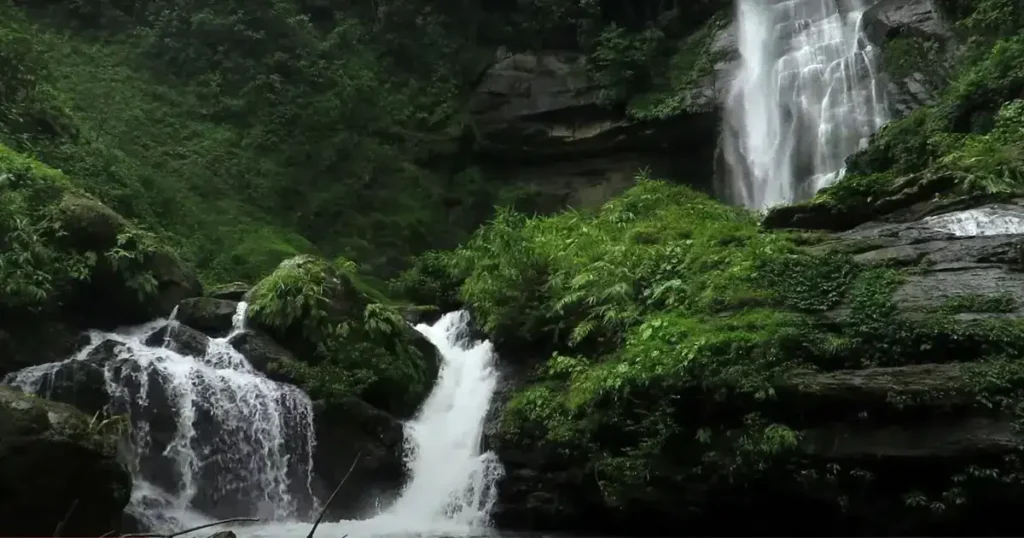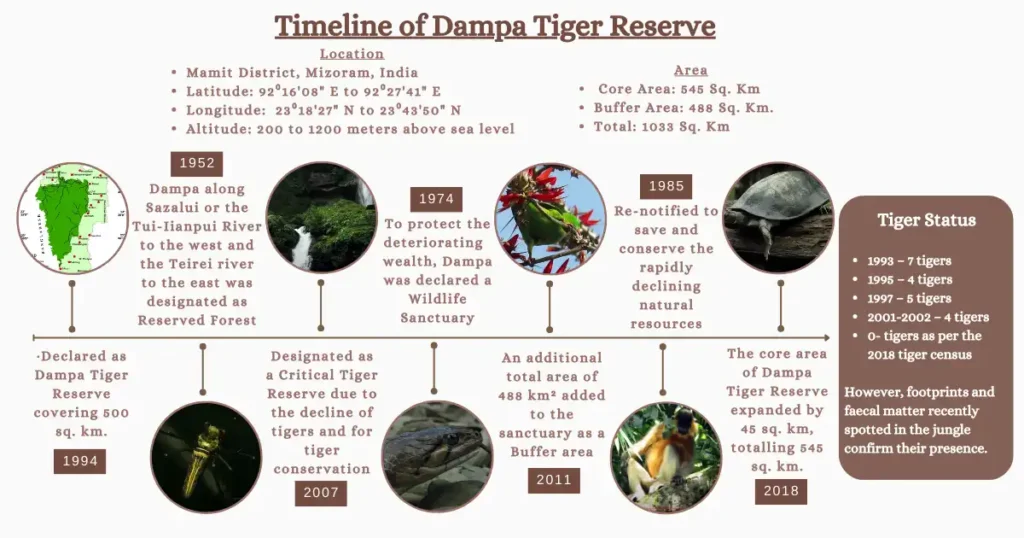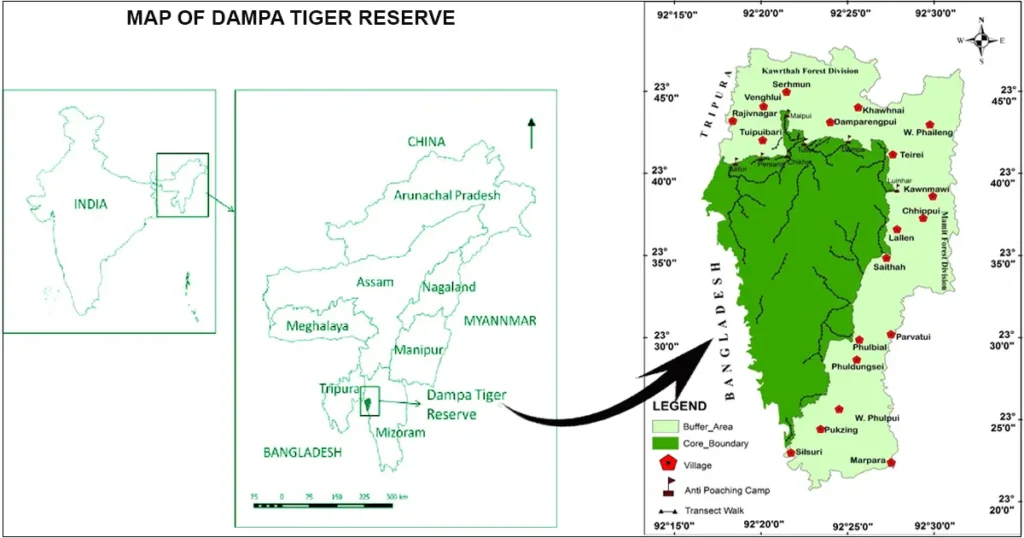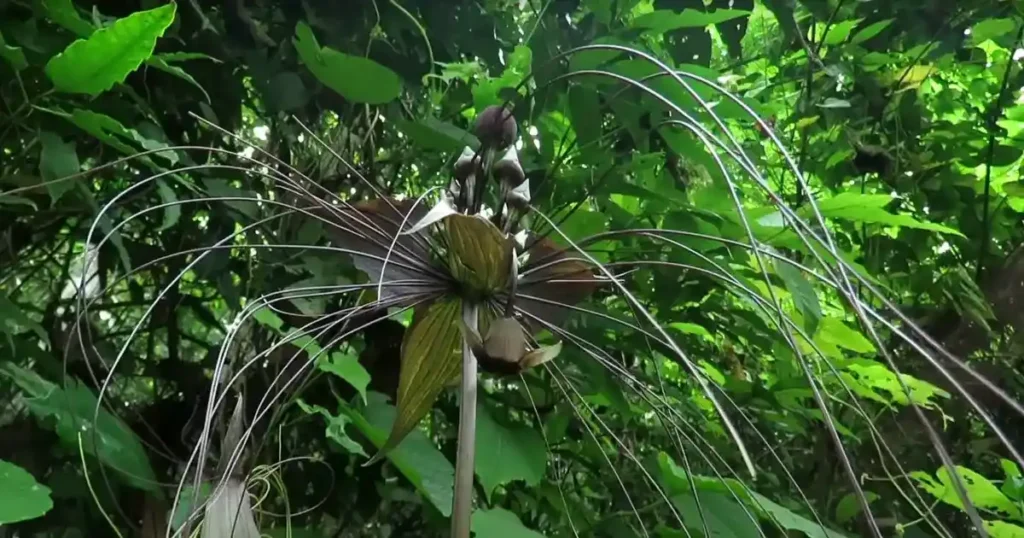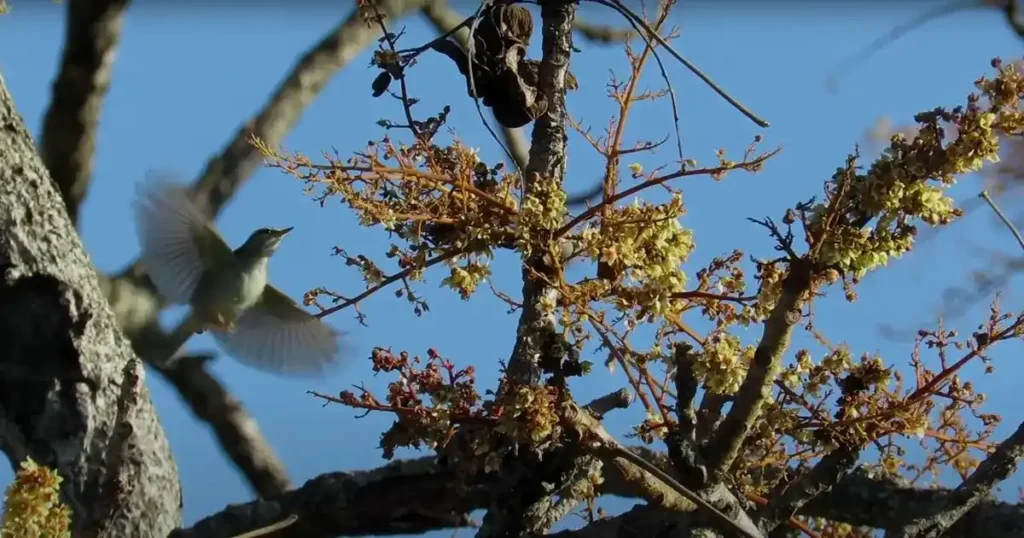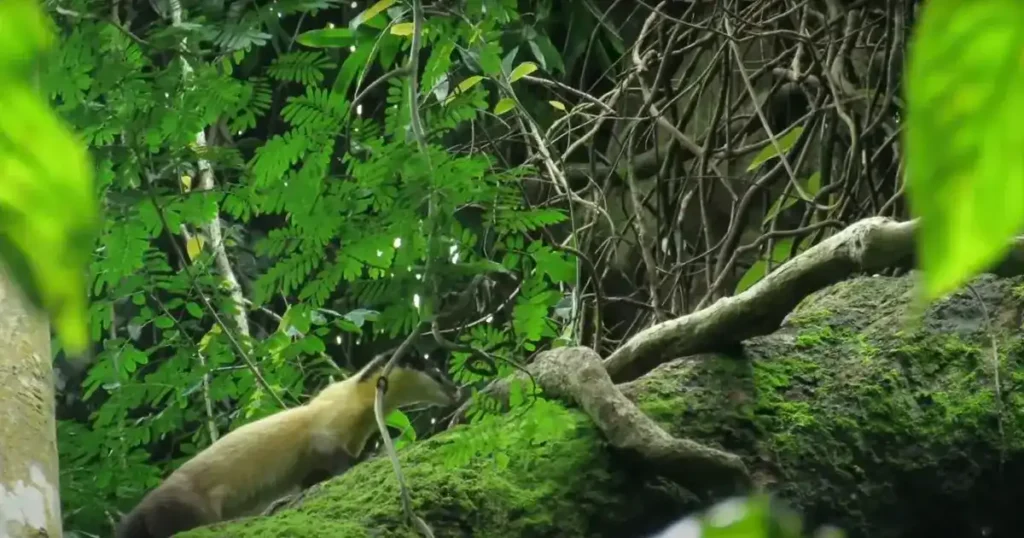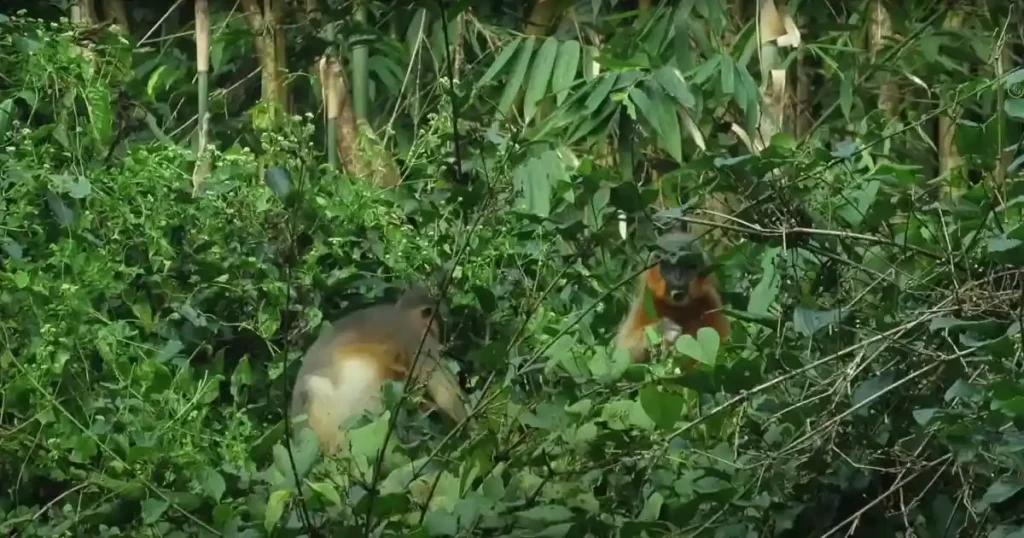Covering a total area of 1,033 sq. km, Dampa Tiger Reserve is the largest wildlife protected area in the Indian state of Mizoram. It was declared a Tiger Reserve in 1994. The core zone of Dampa Tiger Reserve is 545 km² and a total area of 488 km² is extended as the buffer zone in March 2011. It is located in the westernmost part of Mamit District in the Indian state of Mizoram, at the tri-junction of Bangladesh and two Indian states viz- Mizoram and Tripura.
The Khawthlangtuipui River originating from Saithah village in Mamit district flows 270 km southwest through the Chittagong Hill Tracts into the Bay of Bengal forming the international border with Bangladesh. The Tropic of Cancer runs through Dampa Tiger Reserve passing near the range office at Phuldungsei.
Dampa Tiger Reserve has lush tropical forests with a mix of plants and animals. It has one of the last remaining natural low- to mid-elevation forests in western Mizoram. The area has steep hills, deep valleys, jungle streams and natural salt licks. Unlike some parks where you can use a four-wheeler, Dampa Tiger Reserve requires walking through the forest to spot animals because it’s not easily accessible.
Dampa Tiger Reserve Map and its Boundary
Dampa Tiger Reserve is surrounded by the Chittagong Hill Tracts of Bangladesh to the west, Tripura State, Mamit and Kawrthah forest divisions to the north and Mamit Forest division to the south and east. The area is located in the Lushai hills, a series of parallel mountain ranges connected to the Arakan Yoma area. Tribes like Mizo, Chakma and Tuikuk(Bru) are living near the tiger reserve. Damparengpui is the closest village to the reserve. The reserve is very close to and also visible from West Phaileng village. The majority of population around Dampa Tiger Reserve are mostly Christians, Buddhists and Hindu. The villagers near the reserve practice jhum cultivation, a form of shifting cultivation for their livelihood.
The boundary begins where Sailui meets Sazalui. It then follows Sazalui upstream until it meets Belkhailui in the western part of Dampa Tiger Reserve. The northern boundary starts where Belkhailui meets Sazalui until it meets Tut River in Daplui downstream. The eastern boundary begins where Daplui meets Tut River and follows Marlui downstream until it meets Lunghrelui. The southern boundary starts where Lunghrelui meets Marlui until it meets Sazalui/Tuilianpui.
The geographical coordinates of Dampa Tiger Reserve lie between 92⁰16’08” E to 92⁰27’41” E and 23⁰18’27” N to 23⁰43’50” N.
Dampa Tiger Reserve Photos: Map showing the area of Dampa Tiger Reserve
History of Dampa Tiger Reserve
- The riverine area to the east and west of DAMPA along the Khawthland Tuipui (also known as Sazalui or the Tui-Iianpui River to the west and the Teirei river to the east) was designated as Reserved Forest in 1952.
- In the early 1960s, small settlements started appearing in Dampa forest for intense farming in the lower areas. This had a detrimental effect on the variety of plants and animals in the region. To protect the deteriorating natural wealth, Dampa was declared a Wildlife Sanctuary in 1974.
- In 1985, it was re-notified to save and conserve the rapidly declining natural resources.
- In 1994, the government of Mizoram officially declared Dampa Wildlife Sanctuary as Tiger Reserve covering 500 sq. km through Gazette notification No. B-11011/14/90-FST on 7th December 1994 with the approval of the Government of India.
- In 2007, Dampa Tiger Reserve which was established over 500 sq. km in 1994 was designated as a Critical Tiger Reserve due to the decline of tigers and for tiger conservation by the Government of Mizoram through notification No. B12011/52007-FST, dated 28th December 2007.
- On 16th March 2011, an additional total area of 488 km² was added to the sanctuary as a Buffer area.
- Furthermore, in 2018, the Governor of Mizoram extended the core area of Dampa Tiger Reserve through notification No. B.12012/20/2013-FST, dated 6th September 2018, to protect, support and enhance the wildlife in the region due to its ecological, faunal, geomorphological, natural or zoological importance. The expansion included adding the nearby area of Serhmun Village Council, totalling 45 sq. km, to the sanctuary. This brings the total core area of Dampa Tiger Reserve including the expanded sanctuary to 545 sq. km.
Dampa Tiger Reserve Photos : Tacca Integrifolia (Bat Plant)
In the core area of Dampa Tiger Reserve, the focus is on wildlife protection and management. The Forest Department provides livelihood alternatives and eco-development activities in the surrounding buffer area to reduce dependence on core resources.
The buffer area is divided into two zones:
- Eco Development Zone: Includes human settlements, agriculture, horticulture, fisheries and jhum land. Eco-development activities are carried out through participatory village-level plans to decrease the community’s reliance on park resources.
- Forested Zone: Divided into Western, Northern, Eastern, and Southern boundaries, this zone involves local participation for protection. Regulations are in place for the collection of timber and non-timber forest products. Timely compensation is provided for human-wildlife conflicts such as loss of life, livestock and crop damage.
The details of Dampa Tiger Reserve:
- Date of notification as DAMPA TIGER RESERVE: 7th December 1994, core area 500 Sq. Km.
- Date of notification of buffer zone: 16th March 2011, Buffer/Peripheral area: 488 Sq. Km.
- Date of extended the core area: 6th September 2018, core area 45 Sq. Km.
Area of the tiger reserve:
- Core/critical tiger habitat: 545 Sq. Km
- Buffer/Peripheral area: 488 Sq. Km
- Total: 1033 Sq. Km
Location of Dampa Tiger Reserve
Geography of Dampa Tiger Reserve
1. The Varied Landscapes and Flora:
The geography of Dampa Tiger Reserve has different types of landscapes and plants that form an intermingling of atmospheres. The reserve spans mountainous terrain with altitude ranging from 200 to 1200 meters above sea level. Situated on the Tropic of Cancer, Dampa experiences distinct seasons: mild winters (December to February, averaging 15°C), warm summers and a rainy season from May to October. The area is covered with semi-evergreen forests and tropical evergreen forests along with tropical moist deciduous forests. At higher elevations, above 700 meters above sea level it is covered with sub-montane forests.
2. Flora on the Lower Plain:
In the lower plains and foothills, tropical evergreen and semi-evergreen forests have tall trees, vines and a layered appearance with various flora including epiphytic plants and lianas. In certain areas there are tropical moist deciduous forests with trees such as Altingia excelsa, Mesua ferrea and Dysoxylum binectariferum. The higher slopes have species such as Mesua ferrea, Schima wallichii, Castanopsis indica and sporadically Quercus.
3. Flora on the Steep Slopes:
On the steep western slopes, the area comprises more open forest areas with deciduous species such as Lannea coromandelica, Sterculia villosa, Gmelina arborea along with large patches of Dendrocalamus longispathus bamboo and open grassy areas on rocky terrain on the highest slopes.
The geography of Dampa Tiger Reserve and its natural vegetation thus include a mix of habitats ranging from grasslands and open forests to dense, tall, primary evergreen forest.
Dampa Tiger Reserve Photos : Yellow Browed Warbler
Major Habitat, Flora, and Fauna in Dampa Tiger Reserve
1. Flora:
The main forest type of Dampa Tiger Reserve is the Assam Valley tropical semi-evergreen forest with a mix of evergreen and semi-evergreen vegetation. The forests are dense with a variety of plant species and rich in epiphytic flora and woody lianas. Some common trees found in the reserve are Tetrameles nudiflora, Ailanthus grandis and Altingia excelsa. Various forest types dominate different areas of the reserve ranging from tropical semi-evergreen forests in lower plains to sub-tropical broadleaved forests on hilltops Bamboo, cane and palms thrive in moist areas near streams and different plant species like Dillenia indica and Talauma hodgsonii are found in lowland moist forests. Larger rivers have isolated trees such as Bombax ceiba and Albizzia species.
2. Wild Animals:
The Dampa Tiger Reserve have been recorded around 59 mammal species including 16 threatened species (6 endangered and 10 vulnerable) as well as 31 species of amphibians and 30 species of fishes. Various species of Felids found in the reserve are Leopards, Jungle cats, Clouded leopards, Asiatic golden cats, Marbled cats, Leopard cats, and Fishing cats. Other common carnivores include Asiatic black bears, Malayan sun bears, Wild dogs and Jackals.
The herbivores species in the area include Sambars, Gaurs, Wild boars Serows, Barking deer, and Asiatic elephants.
The reserve also houses important primates such as Western hoolock gibbons, Phayre’s leaf monkeys, Assamese macaques, Capped langurs, Slow lorises, Stump-tailed macaques, Northern pig-tailed macaques and Rhesus macaques.
The other different kinds of animals found in the area are Large Indian civets, Yellow-bellied weasels, Striped-backed weasels, Malayan giant squirrels, Binturongs, Crab-eating mongooses, red flying squirrels, small Indian civets, Chinese pangolins, brush-tailed porcupines, small-clawed otters, Chinese and Burmese ferret badgers, Himalayan crestless porcupines, hog badgers and yellow-throated martens.
Dampa Tiger Reserve Photos : Yellow Throated Martin
3. Tiger Status:
There are very a smaller number of tigers in Dampa Tiger Reserve which is as follows:
- 1993 – 7 tigers
- 1995 – 4 tigers
- 1997 – 5 tigers
- 2001-2002 – 4 tigers
As per the 2018 tiger census report in India, no tigers were found in Dampa Tiger Reserve. But after seven years, researcher spotted a tiger in the reserve recently.
According to the Forest Guard of Dampa Tiger Reserve, Bengal Tigers have not been spotted in the reserve, even by setting camera traps, which may be due to the fact that the reserve area is very large. However, they have seen their footprints and faecal matter in the jungle recently and this proves that Bengal Tigers do indeed dwell in the reserve area.
4. Avifauna:
Dampa Tiger Reserve is designated as one of the Important Bird Areas (IBA) in India owing to its significant avian wealth. So far 237 bird species have been recorded in the reserve of which 148 species are forest birds.
The variety of bird species found in the Dampa Tiger Reserve are Imperial Pheasant, Lesser Racket-Tailed Drongo, Grey Peacock-Pheasant, Wreathed Hornbill, White-Throated Kingfisher, Red Jungle Fowl (Ramar), Greater Racket-Tailed Drongo, Black Baza, Black Stork, Oriental Honey Buzzard, Kalij Pheasant, Red-Headed Trogon, Mountain Bamboo Partridge, Oriental Hornbill, Pied Hornbill, Oriental Dwarf Kingfisher, Common Hawk-Cuckoo, Violet Cuckoo, Common Kingfisher, Stork-Billed Kingfisher, Indian Cuckoo, White-Checked Partridge, Bhutan Peacock Pheasant, Eurasian Cuckoo, Jerdon’s Baza etc.
Birds like Lesser Whistling Teal and Black Stork have been spotted using camera traps in Dampa Tiger Reserve. This discovery is important because Lesser Whistling Teal wasn’t known to be in the geographical area of Dampa before.
Dampa Tiger Reserve Photos : Oriental White-eye bird
Major Attraction of Dampa Tiger Reserve
Important information is put on Notice Boards by the officials of Department of Environment & Forest, Govt of Mizoram for visitors to the Dampa Tiger Reserve (DTR). The reserve’s major attractions include-
1. The Rich Birdlife and Biodiversity of Dampa:
Numerous varieties of birds can be spotted in Dampa Forest. Lots of huge primordial trees of different species are to be seen in the forest. Food is plentiful for all types of animals in the Dampa forest, making it impossible for them to leave. Hence, the forest remains a haven for different animal species. It is recorded that there are around 300 species of birds in the Dampa forest, but the staff at Dampa Tiger Reserve believes that the actual number could be higher than the recorded figure. Birds that hunt for food on land, like Kalij Pheasant, Red Jungle Fowl, Grey Peacock Pheasant, and White-eared Partridge/Common Hill Partridge, are numerous in numbers.
2. Fertile Soil and Giant Earthworms:
The soil in Dampa forest is truly fertile and even the earthworms in the area are much bigger as compared to other places. Giant snails which are thought to vanish in other place of Mizoram are still to be seen in the reserve area. Unusually beautiful species of caterpillars are also numerous.
3. Diverse Wildlife:
There are numerous species of poisonous and non-poisonous snakes abiding in the forest. The reserve was documented about 23 species of snakes from seven families and 16 genera. Even different varieties of fresh water crabs are abundant in the forest.
In the Dampa Tiger Reserve there are many wild animals like bear, Mithun, deer, wild elephant, leopard, Asiatic wild dogs and many more. The density of Clouded leopard population in DTR is estimated at 5.14 per 100 sq. km.
Dampa Tiger Reserve Photos : Bamboo Pit Viper
4. The Lone Elephant of Dampa Tiger Reserve:
There were five elephants in the year 1995, three were killed by underground militants while one as killed by poachers. Only one remains alive without a mate. This elephant often destroys crops and jungle huts, posing a very danger to the farmers who try to protect their farms.
Wild animals differ greatly in the way they hunt for food. Some hunt during the daytime, while others hunt at night. Porcupines, which hunt for their food at night can be spotted in the DTR.
5. Hill view from Pathlawi Lunglen Tlang:
It is really satisfying to view the breathtaking mountain ranges of Hachhek and Mamit from Pathlawi Lunglen Tlang, a superb spot at a mountain top in the forest. The forest is still very dense hence rainfall is highly abundant, hence, the villagers near Dampa Reserve Forest receives plentiful rainwater. The soil in the forest is still very rich. During the monsoon, soil dwellers like insects and worms leave their rain-drenched homes and come out in the forest.
Several areas in the jungle, about 1 acre, area declared by the Department of Forest & Environment so that meadows may be formed so that it will aid the carnivorous wild animals like tigers, in catching their prey.
6. Endangered Spectacled Monkey:
Amongst the several species of monkeys that resides in Dampa forest spectacled monkey is a notable one as it is found only in Mizoram and Tripura and are listed as endangered species by the IUCN and needs to be protected vigilantly.
Dampa Tiger Reserve Photos : Capped Langur
How to go Dampa Tiger Reserve
To visit Dampa Tiger Reserve one cannot just enter the area without getting permission from Chief Wildlife Warden located at Phuldungsei Wildlife Range. The Department of Environment, Forest, and Climate Change constructed a Rest House at Teirei and Damparengpui villages in 2005 where visitors could stay during their visit to the reserve.
Connectivity
By Road
To reach the Dampa Tiger Reserve by road, you can take either of the following routes starting from Aizawl:
- Aizawl – Tuipuibari West – Phaileng Teirei – Aizawl: The distance for this route is 107 km.
- Aizawl – Tuipuibari West – Phaileng Phuldungsei: This route is 140 km long
By Rail
The closest railway station is Bairabi in Kolasib District of Mizoram, approximately 80 km away from West Phaileng.
By Air
The nearest airport is Lengpui, located 60 km from West Phaileng. Daily flights from Delhi, Kolkata, and Guwahati operate to Lengpui airport.
The best season to visit Dampa Tiger Reserve is October to April.
Conclusion
Dampa Tiger Reserve, situated in the Mamit District of Mizoram along the Bangladesh border covering a total area of 1033 sq.km, is characterized by tropical evergreen to semi-evergreen forests, tropical moist deciduous forests, and sub-montane types with rich flora and fauna. The reserve has around 300 species of birds, 23 species of snakes, 59 mammal species including 16 threatened species (6 endangered and 10 vulnerable) as well as 31 species of amphibians and 30 species of fishes.
Unlike some parks where you can use a four-wheeler, Dampa Tiger Reserve requires walking through the forest to spot animals because it’s not easily accessible. Visitors to Dampa Tiger Reserve need to obtain permission from the Chief Wildlife Warden at Phuldungsei Wildlife Range before entering the area. There are Rest Houses at Teirei and Damparengpui villages where visitors could stay during their visit to the reserve.
FAQ
a) What is the Dampa Tiger Reserve famous for?
Dampa Tiger Reserve is famous for its high density of Clouded leopard population, estimated at 5.14 per 100 sq. km. The reserve, covering a total area of 1,033 sq. km, is the largest wildlife protected area in the Indian state of Mizoram and is rich in flora and fauna.
b) How many tigers are in Dampa?
In 2001-2002, four tigers were recorded in Dampa Tiger Reserve. However, the 2018 tiger census report in India showed no tigers in the reserve. Recently, researchers spotted a tiger after seven years. According to the Forest Guard of Dampa Tiger Reserve, Bengal Tigers have not been observed in the reserve, even with camera traps, possibly due to the large reserve area. However, footprints and faecal matter recently spotted in the jungle confirm their presence.
c) Which river flows through Dampa Tiger Reserve?
The river Khawthlangtuipui flows through the Dampa Tiger Reserve in the West forming the international border with Bangladesh and the Teirei River to the East. The tributaries of Teirei River such as Seling, Aivapui and Keisalam also flow through the reserve.
You May Also Like
- Chakrashila Wildlife Sanctuary
- Sonai Rupai Wildlife Sanctuary
- Bornadi Wildlife Sanctuary
- Garampani Sanctuary
- Bura Chapori Wildlife Sanctuary

